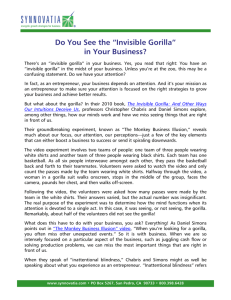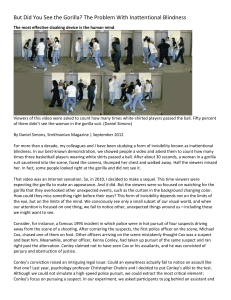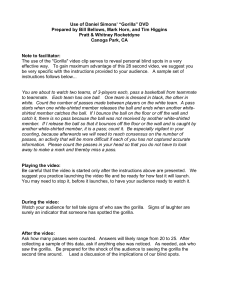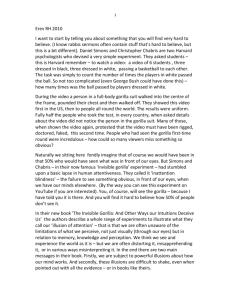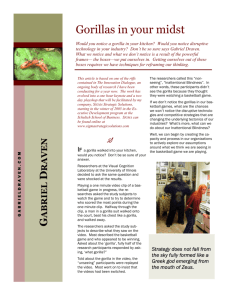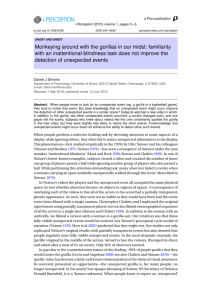spotting your invisible gorilla
advertisement
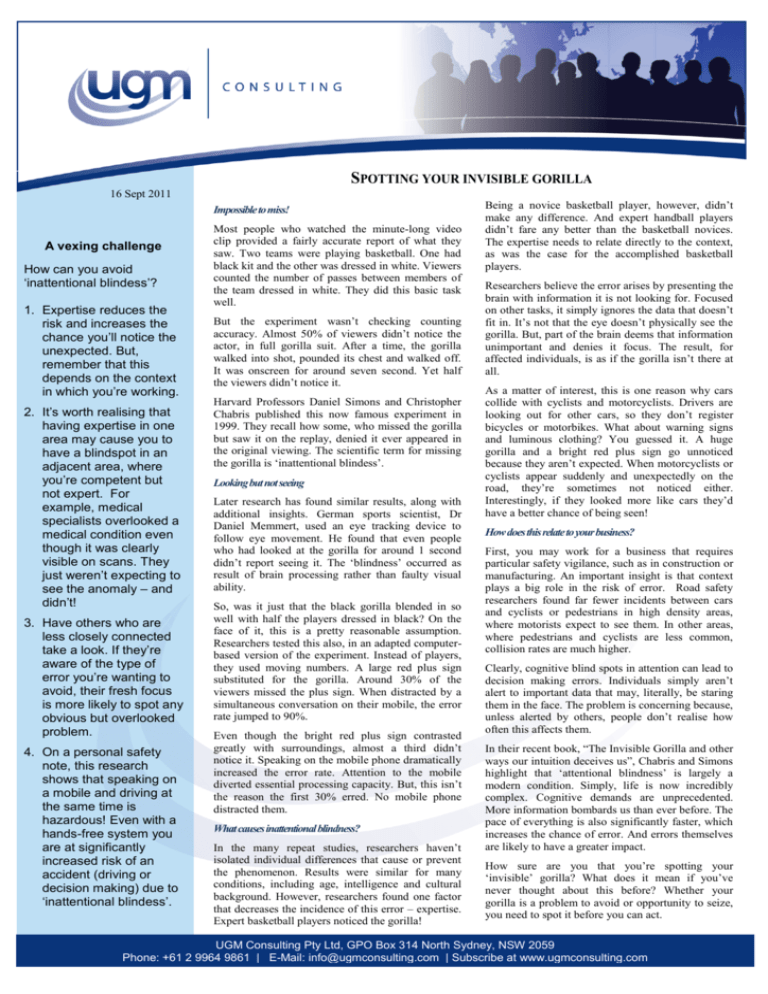
SPOTTING YOUR INVISIBLE GORILLA 16 Sept 2011 Impossible to miss! A vexing challenge How can you avoid ‘inattentional blindess’? 1. Expertise reduces the risk and increases the chance you’ll notice the unexpected. But, remember that this depends on the context in which you’re working. 2. It’s worth realising that having expertise in one area may cause you to have a blindspot in an adjacent area, where you’re competent but not expert. For example, medical specialists overlooked a medical condition even though it was clearly visible on scans. They just weren’t expecting to see the anomaly – and didn’t! 3. Have others who are less closely connected take a look. If they’re aware of the type of error you’re wanting to avoid, their fresh focus is more likely to spot any obvious but overlooked problem. 4. On a personal safety note, this research shows that speaking on a mobile and driving at the same time is hazardous! Even with a hands-free system you are at significantly increased risk of an accident (driving or decision making) due to ‘inattentional blindess’. Most people who watched the minute-long video clip provided a fairly accurate report of what they saw. Two teams were playing basketball. One had black kit and the other was dressed in white. Viewers counted the number of passes between members of the team dressed in white. They did this basic task well. But the experiment wasn’t checking counting accuracy. Almost 50% of viewers didn’t notice the actor, in full gorilla suit. After a time, the gorilla walked into shot, pounded its chest and walked off. It was onscreen for around seven second. Yet half the viewers didn’t notice it. Harvard Professors Daniel Simons and Christopher Chabris published this now famous experiment in 1999. They recall how some, who missed the gorilla but saw it on the replay, denied it ever appeared in the original viewing. The scientific term for missing the gorilla is ‘inattentional blindess’. Looking but not seeing Later research has found similar results, along with additional insights. German sports scientist, Dr Daniel Memmert, used an eye tracking device to follow eye movement. He found that even people who had looked at the gorilla for around 1 second didn’t report seeing it. The ‘blindness’ occurred as result of brain processing rather than faulty visual ability. So, was it just that the black gorilla blended in so well with half the players dressed in black? On the face of it, this is a pretty reasonable assumption. Researchers tested this also, in an adapted computerbased version of the experiment. Instead of players, they used moving numbers. A large red plus sign substituted for the gorilla. Around 30% of the viewers missed the plus sign. When distracted by a simultaneous conversation on their mobile, the error rate jumped to 90%. Even though the bright red plus sign contrasted greatly with surroundings, almost a third didn’t notice it. Speaking on the mobile phone dramatically increased the error rate. Attention to the mobile diverted essential processing capacity. But, this isn’t the reason the first 30% erred. No mobile phone distracted them. What causes inattentional blindness? In the many repeat studies, researchers haven’t isolated individual differences that cause or prevent the phenomenon. Results were similar for many conditions, including age, intelligence and cultural background. However, researchers found one factor that decreases the incidence of this error – expertise. Expert basketball players noticed the gorilla! Being a novice basketball player, however, didn’t make any difference. And expert handball players didn’t fare any better than the basketball novices. The expertise needs to relate directly to the context, as was the case for the accomplished basketball players. Researchers believe the error arises by presenting the brain with information it is not looking for. Focused on other tasks, it simply ignores the data that doesn’t fit in. It’s not that the eye doesn’t physically see the gorilla. But, part of the brain deems that information unimportant and denies it focus. The result, for affected individuals, is as if the gorilla isn’t there at all. As a matter of interest, this is one reason why cars collide with cyclists and motorcyclists. Drivers are looking out for other cars, so they don’t register bicycles or motorbikes. What about warning signs and luminous clothing? You guessed it. A huge gorilla and a bright red plus sign go unnoticed because they aren’t expected. When motorcyclists or cyclists appear suddenly and unexpectedly on the road, they’re sometimes not noticed either. Interestingly, if they looked more like cars they’d have a better chance of being seen! How does this relate to your business? First, you may work for a business that requires particular safety vigilance, such as in construction or manufacturing. An important insight is that context plays a big role in the risk of error. Road safety researchers found far fewer incidents between cars and cyclists or pedestrians in high density areas, where motorists expect to see them. In other areas, where pedestrians and cyclists are less common, collision rates are much higher. Clearly, cognitive blind spots in attention can lead to decision making errors. Individuals simply aren’t alert to important data that may, literally, be staring them in the face. The problem is concerning because, unless alerted by others, people don’t realise how often this affects them. In their recent book, “The Invisible Gorilla and other ways our intuition deceives us”, Chabris and Simons highlight that ‘attentional blindness’ is largely a modern condition. Simply, life is now incredibly complex. Cognitive demands are unprecedented. More information bombards us than ever before. The pace of everything is also significantly faster, which increases the chance of error. And errors themselves are likely to have a greater impact. How sure are you that you’re spotting your ‘invisible’ gorilla? What does it mean if you’ve never thought about this before? Whether your gorilla is a problem to avoid or opportunity to seize, you need to spot it before you can act. UGM Consulting Pty Ltd, GPO Box 314 North Sydney, NSW 2059 Phone: +61 2 9964 9861 | E-Mail: info@ugmconsulting.com | Subscribe at www.ugmconsulting.com

